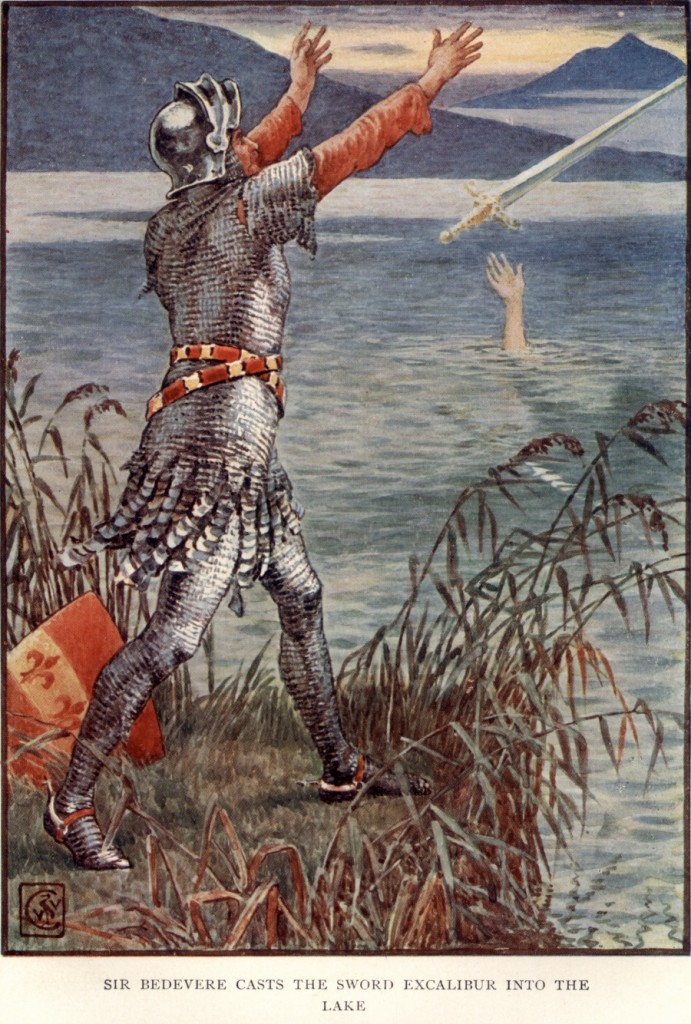The Origins of Excalibur and Late Medieval Funerals June 9, 2016
Author: Beach Combing | in : Ancient, Medieval, Prehistoric , trackback
It is perhaps the single most famous image from the Arthurian canon: the sword being returned to the water, into the grasp of the Lady of the Lake. Beach includes here the scene from the 1981 film Excalibur, which caused his seven year old daughter to audibly gasp when she watched it this morning.
Scholars have argued about the symbolism and origins of the sword as it travels in and out of the lake for years: mistranslations from Welsh and Latin, Scythia (out of Asia) theories, Freudian symbolism (of course), the dying and reborn king… and for all this blogger knows class struggle and the pre-Columbian discovery of the Americas. However, none even vaguely interested Beach until he recently came across a suggestion by Ronald Hutton that he found intriguing. While commenting on a medieval custom of throwing weapons into the waters in the Witham Valley in Lincolnshire (examined by two archaeologists Stocker and Everson), a fenland area, Hutton wrote.
In particular, Stocker and Everson pointed out that the deposition of weapons had declined when the custom of hanging military equipment around tombs became fashionable. In that case, it would have been the weaponry of dead lords which was cast into the water as their bodies were taken for burial at the monasteries. Such a hypothesis has obvious implications for the interpretation of one of the most famous moments in late medieval literature, when Sir Bedivere throws the sword of the dying King Arthur into the lake.*
It might be useful here to return to Stocker and Everson’s paper and start with the facts.
First: this was a landscape with an unusual concentration of bronze age burials; flooding had begun in the late bronze age.
Second: in the middle ages there was an extraordinary concentration of monasteries on this stretch of the river.
Third: many weapons were found around the causeways leading from the river across a flooded landscape. There is some question about whether the causeways were built to cater to ritual habits or whether they preceded them.
Fourth: the weapons dated from the sixth-century BC to the fifteenth century AD [incredible]
Fifth: these weapons were clustered around the causeways but often so far from land that they had probably been dropped by boat.
Sixth: it is reasonable to call these weapons ‘deposits’ as accidental loss or ‘dumping’ after a battle, in certain confined areas, over several centuries is just too much to credit to chance.
From here on in, the speculation begins. Speculation, note, for matters like this is absolutely healthy and Stocker and Everson are very good at separating the facts from their interesting hypotheses. But for the sake of clarity none of the following are terra firma. They are possibilities.
First, the link between the end of ritual deposition and the beginning of a custom, in the fourteenth-century of hanging weapons on graves in churches is not proven. Some of the medieval weapons are difficult to date – note at Martin Kirkstead there was a 15C weapon – and how quickly would this custom have spread around the country? The connection between funerals and weapon deposits depends on this uncertain link. (Reread the Hutton quote above).
Second, the authors stress that this area marked the border of the early medieval kingdom of Lindsey: that the weapons were possibly guarding the river. We have no idea, though, whether such a border existed back into the Bronze Age and it seems to have vanished by the eighth century.
Third, much is made of the Christianisation of pagan customs, but there is no evidence that the church approved of the ritual deposition of weapons in the Middle Ages, let alone that they supervised X throwing Dad’s old sword into the river. We have, with every year that passes, more evidence for whole areas of medieval life that existed in a Pluto-like orbit in relation to the Church.
Stepping back and looking at the material brought together by Stocker and Everson the most remarkable thing is the demonstrable continuity of a series of ritual deposits from the Bronze Age to the War of the Roses. We often talk about such possibilities, but here continuity has been confirmed beyond reasonable doubt. As to Hutton’s point about Excalibur the idea of weapon’s being deposited at funerals remains unproven. There are other possibilities: perhaps a local lord would throw his weapon into the lake when he got a new one? However, even in this case Hutton’s parallel is striking: such customs surely give us insights into the Excalibur legend, and certainly would have defined how medieval listeners or readers in Lincolnshire reacted to the stories. The wider question, of course, is: do we have here a weird Lincolnshire custom; or is this something that can be paralleled up and down Britain at this date? Any other thoughts on Excalibur origins/customs? drbeachcombing AT yahoo DOT com
Source:
Ronald Hutton, ‘Introduction’, Physical Evidence for Ritual Acts, Sorcery and Witchcraft in Christian Britain: A Feeling for Magic (2016)
David Stocker and Paul Everson, ‘The Straight and Narrow Way: Fenland Causeways and the Conversion of the Landscape in the Witham Valley, Lincolnshire’, Martin Carver (ed) The Cross Goes North (York 2003), 271-287
*Note that Stocker and Everson had themselves made a much lighter connection with the return of Excalibur to a watery grave. ‘What is more, the deposition of swords – the symbols perhaps of those Lindsey lordships – in the boundary river might be seen as a symbolic ‘defence’ of the approaches to Lindsey, much as Excalibur was the symbol of Arthur’s defence of his kingdom and had to be returned to the spiritual guardian of the state, the Lady of the Lake, once it had served its purpose in this world.’


